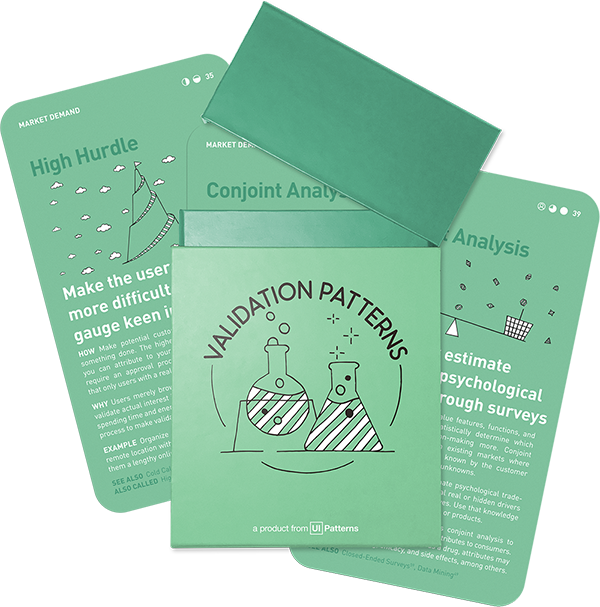
How: Simulate 'purchase now' experience in the form of a simple e-commerce checkout or a pricing page leading to a 'We are not ready yet' page, 'out of stock' message, a letter of intent, or a similar elegant way of letting the user finish without actually billing them.
Why: It takes significantly less time to validate willingness to pay by creating a setup that lets users show their intentions through click behavior than implementing an entire payment system or checkout flow.
Don’t leave the user with the wrong impression
Testing whether your potential customers will actually purchase a product, and at what price, by simulating a ‘Purchase now’ experience, is an effective way to assess willingness to pay. The test can take many forms:
- a pricing plan with links
- an e-commerce checkout flow
- a letter of intent request
Although your experiment is just a test to you, chances are it won’t seem like that to participants. To make sure you can live up to expectations, also in the future, make sure that you leave users with an impression that their request wasn’t possible. Simply responding with an “out of stock”, or “we are not ready” can be enough.
However, leaving users hanging with the anticipation of a future response or promise can easily backfire in the future. If you choose not to simply not bill the customer, at the point where they should normally have been billed, explaining why you’re not billing them is good practice.
This experiment helps answer two things:
- Whether customers are willing to pay for your solution
- Whether pricing or payment options influence the conversion rate
Dry Wallet in the form of a waiting list
The use of waitlists by online retailers serves multiple purposes. Primarily, it helps in managing customer expectations for sold-out products. Customers can sign up for notifications when the product is back in stock, maintaining their interest and engagement.
But they also serve another purpose. Waitlists in online retail serve as a strategic tool for managing customer expectations and gauging market demand for sold-out products. They maintain customer interest in products even when they are not immediately available. This method helps retailers understand which products are in high demand, aiding in making smarter inventory decisions. The scarcity created by waitlists enhances the perceived value of products, potentially increasing future sales. Retailers can optimize their stock levels and variety based on the insights gained from waitlist data, striking a balance between supply and demand.
Real life Dry Wallet examples
Buffer
Before developing Buffer, a spoof landing was created to explain the future product. Clicking its Buy button led to a “We’re not ready yet” page and revealed a conversion rate that helped validate willingness to pay. Later, pricing plans were inserted in the middle of the flow to test what pricing point performed best.
Robinhood Markets
To gauge market interest, Robinhood Markets created a pre-launch waitlist, leveraging scarcity and FOMO. With a simplified sign-up and engaging content, they amassed a waitlist of over 1 million, effectively validating the product’s appeal before launch.
A collection of 60 product experiments that will validate your idea in a matter of days, not months. They are regularly used by product builders at companies like Google, Facebook, Dropbox, and Amazon.
Get your deck!Related plays
- Enterprise learn startup experiment examples by Brant Cooper
- Experiment design: 10 concrete examples by Timan Rebel
- Two pricing experiments to discover the perfect price by Timan Rebel
- Enterprise lean startup experiment examples by Brant Cooper
- Is your idea worth it? by Brittany Sumarsono
- Waitlists: How to Secure Sales from Sold Out Products by Drew Melendy

